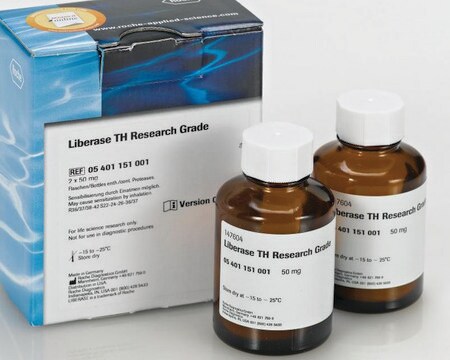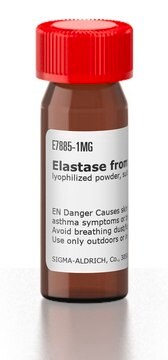Kluczowe dokumenty
LIBTM-RO
Roche
Liberase™ TM Research Grade
medium Thermolysin concentration
About This Item
Polecane produkty
Poziom jakości
Formularz
lyophilized
opakowanie
pkg of 10 mg (05401119001 [2 x 5 mg])
pkg of 100 mg (05401127001 [2 x 50 mg])
producent / nazwa handlowa
Roche
Parametry
35-37 °C optimum reaction temp.
metody
single cell analysis: suitable
tissue processing: suitable
kolor
white
optymalne pH
7.4
rozpuszczalność
water: soluble
przydatność
suitable for flow cytometry
Zastosowanie
life science and biopharma
sample preparation
obecność zanieczyszczeń
Endotoxin 1 EU/mg
Warunki transportu
dry ice
temp. przechowywania
−20°C
Powiązane kategorie
Opis ogólny
Zastosowanie
Cechy i korzyści
- Maximize viability and yield of isolated cells: with an enzyme blend that has less clostripain and trypsin activity, as well as reduced endotoxin content.
- Count on higher specific activity of the enzyme blend: as a result of higher Collagenase I + II purity (determined by HPLC analysis).
- Obtain higher experimental reproducibility: due to higher lot-to-lot consistency.
- Increase safety: with an enzyme that is free of any mammalian or avian tissue-derived raw materials.
Uwaga dotycząca przygotowania
Working concentration: Liberase Research Grade Enzyme Working Concentration
Liberase enzymes have significantly higher specific activities than traditional collagenases. This means that the working concentration of Liberase Research Grade Purified Enzymes, expressed in mg/ml, will be lower than that of traditional collagenase.
When the application is not included on this list, first use Liberase TM Research Grade at a concentration of 0.08–0.28 Wünsch units/ml.The goal is to determine the best starting concentration of Liberase Research Grade Enzyme Blends. This is a starting point, and the final concentration may vary due to differences in procedure and lot-to-lot differences in traditional collagenase.
Collagenase Working Concentration
Multiply your previous collagenase working concentration (mg/ml) by its specific activity (Wünsch units/mg, [as determined above]), to obtain Wünsch units/ml. To determine how much Liberase Research Grade Enzyme Blend to use, first multiply your collagenase working concentration (in Wünsch units/ml) times the total volume of your working enzyme solution to obtain the total collagenase activity needed (Wünsch units). Divide the total collagenase activity required by the Liberase Research Grade stock concentration ( “Reconstitution and Storage”). This indicates how many milliliters of Liberase Research Grade Enzyme Blend stock solution to use in your working enzyme solution.
Storage conditions (working solution): Store unused stock solution in single-use aliquots at -15 to -25 °C.
Note: Avoid repeated freezing and thawing!
Rekonstytucja
Reconstitute the entire vial. Do not weigh individual aliquots of the lyophilizate. The introduction of moisture into the vial results in a decline in enzymatic activity.
Place vial on ice to rehydrate the lyophilized enzyme.
Gently agitate the vial at 2 to 8 °C until enzyme is completely dissolved (max. 30 min).
Depending on the type of tissue-dissociation buffer used to dissolve Liberase Research Grade Purified Enzyme Blends, slight precipitations may be observed which readily dissolve in the dilutedworking solution, and have no influence on enzyme activity.
Remove an aliquot of the stock solution to prepare the working solution.
Reconstitution volume
2 ml (1 vial with 5 mg–10 mg pack size), 10 ml (1 vial with 50 mg–100 mg pack size)
Collagenase Wünsch (units/ml)
13 (1 vial with 5 mg–10 mg pack size), 26 (1 vial with 50 mg–100 mg pack size)
Total Collagenase concentration [mg/ml]
2.5 (1 vial with 5 mg–10 mg pack size), 5.0 (1 vial with 50 mg–100 mg pack size)
Przechowywanie i stabilność
Inne uwagi
Informacje prawne
najczęściej kupowane z tym produktem
Hasło ostrzegawcze
Danger
Zwroty wskazujące rodzaj zagrożenia
Zwroty wskazujące środki ostrożności
Klasyfikacja zagrożeń
Eye Irrit. 2 - Resp. Sens. 1 - Skin Irrit. 2 - STOT SE 3
Organy docelowe
Respiratory system
Kod klasy składowania
11 - Combustible Solids
Klasa zagrożenia wodnego (WGK)
WGK 1
Temperatura zapłonu (°F)
does not flash
Temperatura zapłonu (°C)
does not flash
Wybierz jedną z najnowszych wersji:
Masz już ten produkt?
Dokumenty związane z niedawno zakupionymi produktami zostały zamieszczone w Bibliotece dokumentów.
Klienci oglądali również te produkty
Produkty
Enzyme Explorer Key Resource: Collagenase Guide.Collagenases, enzymes that break down the native collagen that holds animal tissues together, are made by a variety of microorganisms and by many different animal cells.
Powiązane treści
Kolagenazy, enzymy rozkładające natywny kolagen, który utrzymuje tkanki zwierzęce razem, są wytwarzane przez różne mikroorganizmy i wiele różnych komórek zwierzęcych.
Global Trade Item Number
| SKU | GTIN |
|---|---|
| 5401127001 | 4061838251480 |
| 5401119001 | 4061832566801 |
Nasz zespół naukowców ma doświadczenie we wszystkich obszarach badań, w tym w naukach przyrodniczych, materiałoznawstwie, syntezie chemicznej, chromatografii, analityce i wielu innych dziedzinach.
Skontaktuj się z zespołem ds. pomocy technicznej













